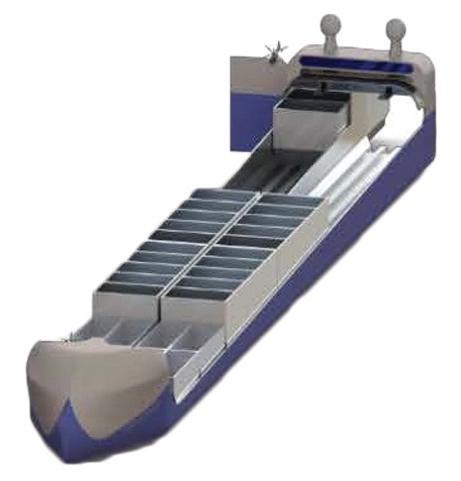
3 minute read
Cruise
LE HAVRE SETS OUT ITS GREEN AGENDA
In this article, Susan Parker talks to HAROPA Le Havre (HLH) on how the port is fulfilling ESPO's November 2020 environmental report
Photo: HAROPA Le Havre
HAROPA Le Havre is working hard to meet ESPO's first three environmental priorities for ports - Air Quality, Climate Change and Energy Efficiency says Baptiste Maurand, managing director, HLH.
With regards dockside power supply for maritime ships, a strategy was launched in 2019 at HLH, firstly prioritising cruiseships (€20 million investment), whose terminal is located close to the city and for which feasibility studies began in 2020 with a goal for completion during 2022/2023.
With regards to river traffic, HLH, in association with VNF, is contributing to the Bornes & Eau (Terminals & Water) programme, co-financed by the EU under the MIE for €1.85 million out of a project total of €9.24 million. The project consists of deploying a network of 78 new terminals allowing distribution of electricity and water to river boats (in addition to the 13 HLH terminals already in use) along the Seine axis.
ALTERNATIVE FUELS
Research is being undertaken by the port to develop a local sector centred around hydrogen - which the port says seems to be the most promising fuel for the future. Research is being undertaken to develop a sector locally, based on hydrogen which seems to be the most promising fuel. Especially since the Seine estuary site - Industrial Zones of Port Jérôme and Le Havre - offers many advantages related to existing and future industrial sites.
The technological monitoring and collaborative approaches underway around this theme are also being conducted internationally in connection with other ports through its participation in national working groups - the French Gas Association's Maritime and River Fuels Commission - as well as internationally: WG Clean Marine Fuels of the International Association of Ports and Harbours or the World Port Climate Action Programme on Low- or Zero-emission Marine Fuels.
Among the fuels targeted are LNG, which is already establishing itself as the alternative fuel of choice in shipping; compressed natural gas (CNG), a now mature and widespread solution for land-based mobility; and hydrogen (H2), a fuel of the future at a much less advanced stage of development. To contribute as actively as possible to the decarbonisation of maritime and river transport activities, HLH has made strong commitments by partnering with the World Port Climate Action Plan and joining the Getting to Zero Coalition.
The latter aims to reduce greenhouse gas emissions by at least 50% by 2050 from shipping. To achieve this, the members of this coalition are committed to help with the commissioning of zeroemission vessels and fuels by 2030.
GREEN OBJECTIVES
The port has set itself strategic objectives for the period 2020 through 2025.
Firstly, it intends to achieve 50 mW of photovoltaic electricity generation in 2025 and it plans on reducing its consumption by 15% by 2025 and 40% by 2040
The port will also supply solutions to supply docked vessels with OPS and other alternative energy modes for the cruise terminal and, in particular, certain ro-ro terminals or container activities
In addition, 100% of port equipment using alternative fuels or electricity by 2040.
Notably, it intends to get better with increased supply of alternative fuels to ships and the sharing of best practices, becoming a positive-energy port in 2040.
ENVIRONMENTAL SHIP INDEX
In 2008, as part of the World Port Climate Conference, HLH was one of the six founding ports behind the Environmental Ship Index (ESI), which rewards shipowners who use ships with the least impact on air quality.
In Le Havre in 2012 and then across HLH in 2013, rewards were given to the most virtuous shipping companies.
In order to maintain a significant premium amount, the requirement threshold for granting rewards is regularly revised upwards (today, a container carrier requires at least 44 out of 100 ESI points compared to 25 ESI points in 2012). The ESI premium is doubled for LNG-powered vessels. For windpowered commercial vessels, the ESI premium is increased to 50% of their port fees.
HLH remains a member of the international working group on the development of the ESI, which aims on the one hand to recruit new ports in the use of this index, and on the other hand, to increase the number of vessels signed up to the ESI (currently more than 8000 ships, or 10% of the world's commercial fleet).
8 HAROPA Le Havre










